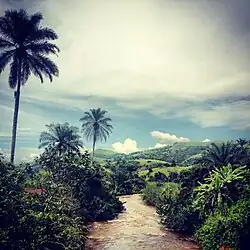Kilungutwe River
The Kilungutwe River is a stream in the Mwenga Territory of the South Kivu Province, in the eastern part of the Democratic Republic of the Congo (DRC).[1] With an elevation of 882 meters, it serves as a tributary to the Ulindi River. Once it merges with the Ulindi River approximately 30 km to the north-west, the Ulindi River continues its course, eventually joining the Congo River.[2][3][4] The Kilungutwe River was historically known as the gateway to the jungle from the highlands to the northeast.[3][5] The river is home to various species of aquatic life, including catfish, tilapia, and mudfish, which are essential to the region's fishing industry. Further downstream, in the Kilungutwe village, the surrounding area is rich in biodiversity, with lush vegetation and a diverse range of flora and fauna. Additionally, the Kilungutwe River is a lifeline for the local economy, providing a crucial source of water for irrigation and fishing. Its impact extends far beyond the village, making it a cornerstone of the larger community's way of life.[6][7][8]
| Kilungutwe River | |
|---|---|
 Kilungutwe River, June 2013 | |
| Location | |
| Country | Democratic Republic of the Congo |
History
Kilungutwe River has a rich cultural heritage. It was conventionally home to several Bantu ethnic groups, including the Lega, Bembe, Shi, Fuliiru, Nyindu, and Vira people that spanned the Central and Eastern African regions, each with their unique customs, languages, and traditions, but share a common ancestry and cultural heritage as Bantu peoples.[9][10]
The river is well known for a massacre that took place during the Second Congo War. The river saw the Rally for Congolese Democracy (RCD), a Rwandan-backed armed group, unleashed a reign of terror upon local Congolese civilians in Kasika village and its neighboring settlements. The atrocities committed by the RCD ranged from deliberate killings, arbitrary arrests, and detentions, to disappearances, harassment of human rights defenders, abuses against women, and recruitment of child soldiers.[11] Many victims were hacked to death with machetes or other sharp objects, while a smaller number were shot. Moreover, some of the women were raped before being disemboweled with daggers from their vaginas, and the little children were subjected to brutal treatment, such as being banged on walls before being thrown into the toilets or in the Kilungutwe River. The Kilungutwe River, once a symbol of peace and serenity, has now become a stark reminder of the atrocities committed during the Second Congo War. It serves as a poignant reminder of the need for humanity to uphold peace and respect for human rights, especially in areas of conflict.[12][13][14][15][16]
References
- "Bukavu : Joseph Kabila clôture sa visite au Sud-Kivu". Radio Okapi (in French). 2009-08-14. Retrieved 2023-05-08.
- Bulletin des séances, Volume 1, Issues 1-6 (in French). Paris, France: Académie royale des sciences coloniales. 1955. pp. 667–675.
- Stearns, Jason (March 27, 2012). Dancing in the Glory of Monsters: The Collapse of the Congo and the Great War of Africa. New York, New York: PublicAffairs. p. 257. ISBN 9781610391597.
- "Google Maps". Google Maps. Retrieved 2023-07-04.
- "Des Hydrocarbures et de l'environnement" (PDF) (in French). Bukavu, Democratic Republic of the Congo. 2016-06-23. p. 6. Retrieved 2023-05-08.
- Association française pour l'avancement des sciences (1953). Actes du congrès, Volume 72 (in French). Secrétariat de l'Association. p. 379.
- Yamada, Takako (1984). Nyindu Culture and the Plant World : The Dynamic Relationship between the Knowledge on Plant Use and the Change in House Form. Kyoto, Japan: Kyoto University.
- "KILUNGUTWE Geography Population Map cities coordinates location - Tageo.com". www.tageo.com. Retrieved 2023-05-08.
- Biebuyck, Daniel P. (1981). Statuary from the Pre-Bembe Hunters: Issues in the Interpretation of Ancestral Figurines Ascribed to the Basikasingo-Bembe-Boyo. Tervuren, Belgium: Royal Museum of Central Afrika. pp. English, French, and Dutch.
- Biebuyck, Daniel P. (1973). Lega Culture; Art, Initiation, and Moral Philosophy Among a Central African People. Berkeley, California: University of California Press. p. 3. ISBN 9780520020856.
- "CASUALTIES OF WAR". www.hrw.org. Retrieved 2023-05-08.
- "RDC: 22 ans après le massacre, retour à Kasika où la blessure des charniers reste vive". RFI (in French). 2020-09-04. Retrieved 2023-05-08.
- "RDC: polémique après un tweet de l'ambassadeur du Rwanda sur le massacre de Kasika". RFI (in French). 2020-08-26. Retrieved 2023-05-08.
- "Life for women in the country that 'never turned the page of conflict'". The Independent. 2019-06-12. Retrieved 2023-05-08.
- "ACHPR, Democratic Republic of the Congo v. Burundi, Rwanda and Uganda | How does law protect in war? - Online casebook". casebook.icrc.org. Retrieved 2023-05-08.
- "20 Years On from the Kasika Massacre, Women Survivors Share Their Stories | Women For Women". Women for Women International. Retrieved 2023-05-08.